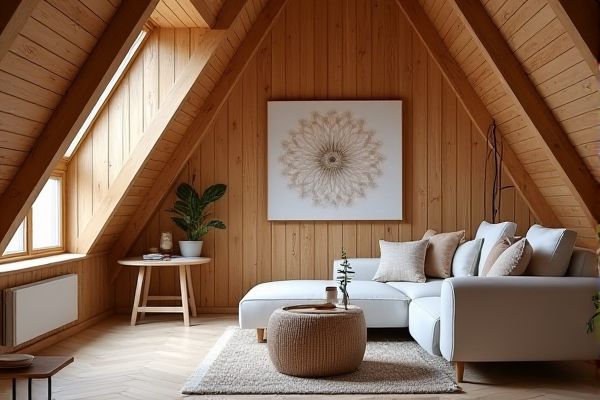
Attic faux wood panels offer a lightweight, cost-effective alternative to real wood panels while providing similar aesthetic warmth and texture, making them ideal for budget-conscious or moisture-prone spaces. Explore the article to discover which option best suits Your attic renovation needs and how to achieve the perfect look for Your home.
Table of Comparison
| Feature | Attic Faux Wood Panel | Real Wood Panel |
|---|---|---|
| Material | Composite or PVC with wood grain finish | Natural hardwood or softwood |
| Appearance | Realistic wood look, often uniform | Authentic wood grain and texture |
| Durability | Moisture-resistant, less prone to warping | Can warp or crack with humidity |
| Installation | Lightweight, easier to install | Heavier, requires skilled installation |
| Maintenance | Low maintenance, easy to clean | Requires periodic sealing or finishing |
| Cost | Generally lower cost | Higher upfront investment |
| Environmental Impact | Made from synthetic materials, less eco-friendly | Biodegradable and renewable resource |
| Longevity | 10-20 years depending on environment | 20+ years with proper care |
Introduction to Attic Wall Paneling Options
Attic wall paneling options include faux wood panels and real wood panels, each offering distinct advantages in terms of cost, maintenance, and aesthetic appeal. Faux wood panels provide a lightweight, moisture-resistant alternative that mimics the natural grain and texture of real wood, ideal for humid attic environments. Your choice depends on desired durability, budget, and the level of authenticity you want to achieve in your attic's design.
What Are Faux Wood Panels?
Faux wood panels are synthetic coverings designed to mimic the appearance and texture of real wood, often made from materials like PVC, MDF, or composite resins. These panels offer a cost-effective, lightweight, and moisture-resistant alternative to genuine wood, making them ideal for attic spaces prone to temperature fluctuations and humidity. Unlike real wood paneling, faux wood requires minimal maintenance and resists warping, cracking, and termite damage while providing similar aesthetic warmth.
Understanding Real Wood Panels
Real wood panels offer natural grain patterns and durability that faux wood panels often lack, providing authentic warmth and texture ideal for attic spaces. These panels are made from solid timber, ensuring better insulation and longer lifespan, which enhances your attic's energy efficiency and aesthetic appeal. Choosing real wood panels means investing in genuine materials that age beautifully and add value to your home.
Cost Comparison: Faux Wood vs Real Wood
Faux wood panels offer a budget-friendly alternative to real wood, typically costing 30-50% less per square foot due to lower material and installation expenses. Real wood panels provide natural durability and authentic aesthetics but often require higher upfront investment and maintenance costs over time. Your choice between faux and real wood panels will depend on balancing cost-effectiveness with the desired look and longevity for your attic.
Installation Process: Ease and Complexity
Attic faux wood panels offer a streamlined installation process with lightweight materials that can be cut easily and often come with peel-and-stick adhesive backing, reducing the need for specialized tools. Real wood panels require careful handling, precise measurements, and tools like saws and nails, making the process more labor-intensive and time-consuming. Choosing faux wood panels can simplify your attic project without sacrificing the wood aesthetic, especially if ease and speed are priorities.
Durability and Longevity of Each Material
Real wood panels offer superior durability and longevity due to their solid natural fibers, resisting wear and aging over decades when properly maintained. Attic faux wood panels, typically made from PVC or composite materials, provide decent durability but may warp or fade faster under extreme temperature changes often present in attic environments. Choosing real wood enhances your attic's value and lifespan, while faux wood offers a cost-effective alternative with moderate resilience.
Aesthetic Differences: Faux Wood vs Real Wood
Faux wood panels in attics offer consistent grain patterns and color uniformity, providing a clean and polished look ideal for modern designs. Real wood panels, however, display unique grain variations and natural imperfections that enhance rustic and traditional aesthetics with authentic warmth and character. You should consider the genuine texture and aging potential of real wood when seeking a timeless appeal, while faux wood ensures easy maintenance and longevity without sacrificing style.
Maintenance and Care Requirements
Attic faux wood panels require minimal maintenance compared to real wood panels, as they resist moisture, pests, and warping, making them ideal for humid or variable attic conditions. Real wood panels demand regular sealing, polishing, and protection from termites and mold to preserve their natural beauty and structural integrity. Your choice affects long-term upkeep time and costs, with faux panels offering a low-maintenance, durable solution.
Environmental Impact and Sustainability
Attic faux wood panels typically have a lower environmental impact due to their production from recycled or synthetic materials, reducing deforestation and resource depletion associated with real wood panels. Real wood panels, while renewable and biodegradable, often contribute to habitat loss and carbon emissions when sourced unsustainably. Opting for certified sustainable wood or high-quality faux alternatives can significantly improve environmental sustainability in attic renovations.
Which Attic Panel is Right for You?
Choosing between attic faux wood panel and real wood panel depends on your budget, aesthetic preferences, and maintenance needs. Faux wood panels offer a cost-effective, lightweight, and moisture-resistant option that mimics real wood's appearance, making them ideal for humid attic environments. Real wood panels provide authentic texture and natural insulation but require regular upkeep and are more susceptible to warping and pests in attic conditions.
 homyna.com
homyna.com